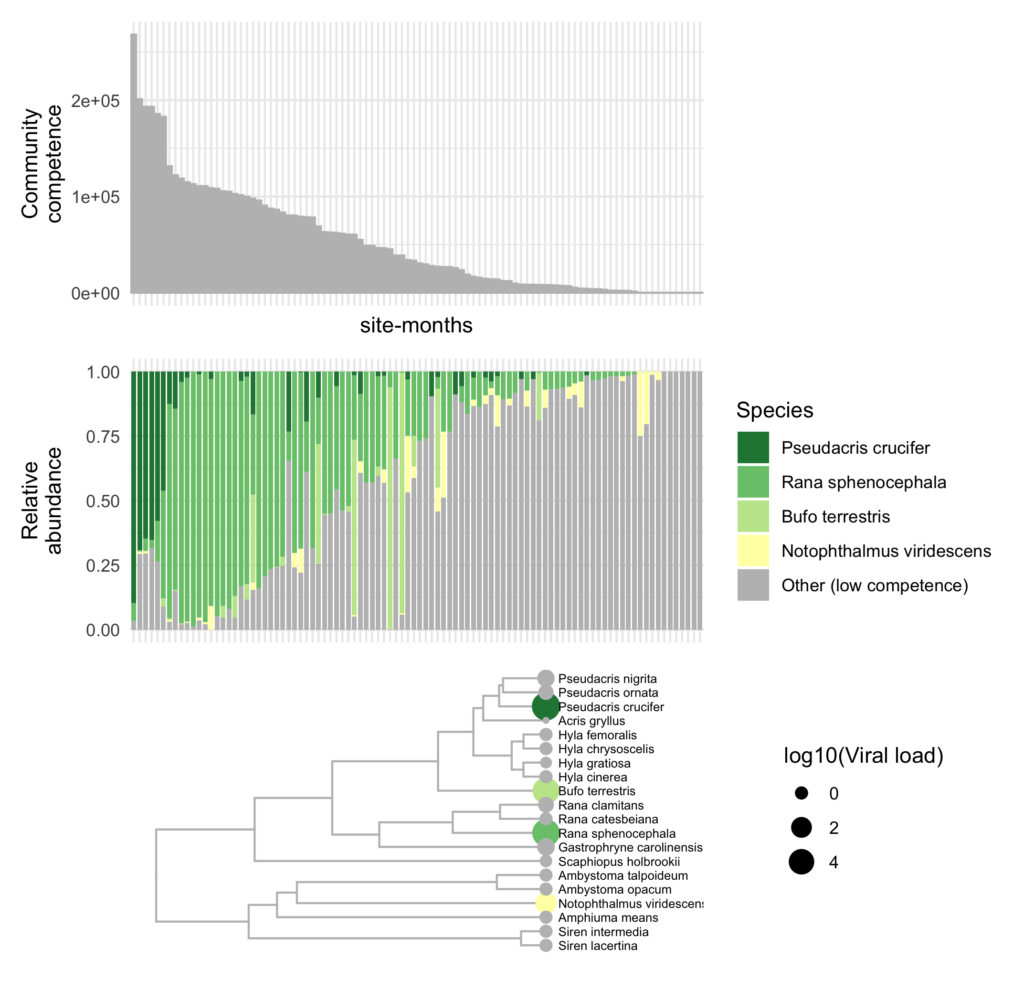In an *UNPRECEDENTED* year, a delayed Ecology and Evolution of Infectious Diseases meeting reformulated into an “Animal Crossing”-esque virtual conference extravaganza. Check out the amazing work OSE students and graduates presented while navigating a complex map full of disease experts, habitat boundaries, and french paraphernalia.
Aedes aegypti outcompetes Anopheles stephensi across a range of larval temperatures
MV Evans, JM Drake, L Jones, CC Murdock

Anopheles stephensi, the primary vector of malaria in urban centers in India, has recently expanded its range across the Middle East and North Africa, raising concern it may become established and contribute to urban malaria transmission in sub-Saharan Africa. In its invasive range, An. stephensi interacts with resident mosquito species, and understanding how these interactions can affect An. stephensi population dynamics is necessary to predict transmission risk at the species’ invasive edge. Further, mosquito life-history traits are extremely sensitive to temperature and competition between mosquito species may be dependent on temperature as well. Here, we explored temperature-dependent competition between An. stephensi and Ae. aegypti across five temperatures (16 – 32 C). We measured traits relevant for population growth from which we estimated each species’ per capita growth rates and derived each species’ competitive ability at each temperature. Ae. aegypti emerged as the dominant competitor at all temperatures, primarily due to differences in larval survival and development times across the two species. Our results suggest that competitive interactions with resident mosquito species, such as Ae. aegypti, could shape the distribution of An. stephensi, and therefore the human population at risk of urban malaria, across its invasive range.
Community composition, abundance, and environmental coditions may synergistically enhance transmission of a ranavirus in larval amphibian communities
Daniel Suh and Andrew Park

Communities of hosts can change through space and time, altering the transmission potential of parasites. We investigated how changes in host composition, total host abundance, and environmental conditions affect a ranavirus in larval amphibian communities. We developed a dynamical model for ranavirus in a 2-species community and manipulated this model in terms of community composition, host abundance, and viral half-life. Next, we measured community competence, diversity (richness, evenness, phylogeny), and overall composition using previously collected amphibian community data. Community competence is the propensity for a community of hosts to support a parasite and was calculated as the sum of the products of each species’ mean viral load and their relative abundance in a community. After calculating these metrics, we used data visualization and correlation tests to detect patterns between our variables of interest (composition, abundance, and environment) and transmission potential of ranavirus.
Our transmission model showed that manipulations of community composition, host abundance, and viral half-life can all enhance a community’s ability to support a parasite, and that when combined, the effects of these variables resulted in communities highly susceptible to ranavirus. Analysis of real host communities confirmed that similar host compositions (according to PCA ordination) had similar community competence, but dissimilar compositions could still result in similar community competence. In our diversity analysis, we found patterns across an evenness gradient but not across richness. We also saw that high competence species appeared intermediately dispersed throughout the phylogeny. Further analysis showed that communities with high community competence were often the most abundant and occurred in months with lower temperatures, resulting in communities highly susceptible to ranavirus. Finally, in univariate correlation tests, community competence, host abundance, and water temperature were all significantly correlated with infection prevalence in host communities.
Parasite and host traits predict the zoonotic risk of protozoa
Joy Vaz, Barbara A. Han, John M. Drake

Protozoan zoonoses such Chagas disease and leishmaniasis remain endemic in large parts of the world, exacerbating social inequity and contributing heavily to the global burden of infectious disease. Novel protozoa species which have emerged from wildlife to humans in the recent decades (e.g., Plasmodium knowlesi, a causal agent of malaria) have proven difficult to control. Our ability to anticipate and prevent future emerging disease threats relies on identifying the characteristics of zoonotic pathogens and targeting surveillance efforts accordingly. While several studies have profiled the traits of zoonotic viruses, protozoa have received limited attention. We compiled a dataset of protozoa species which incorporates both parasite and host traits, including information on community structure and importance within a host-parasite bipartite network. Using a machine learning algorithm, extreme gradient boosting, we distinguished zoonotic from non-zoonotic protozoa with 85% accuracy. Our model found that traits of generalist protozoa (e.g., broad tissue tropism, high network centrality, multiple transmission modes) were most useful for predicting zoonotic status, compared to intrinsic biological traits (e.g., morphology), environmental traits (e.g., temperature), or host-related traits (e.g., life history). We ranked the zoonotic potential of protozoa species currently not known to be zoonotic based on their trait similarity to known zoonotic protozoa. Here we report parasitic protozoa species of wild mammals which are most likely to be undiscovered sources of current or future zoonoses, identifying them as priority targets for surveillance.
Urbanization, food provisioning, and transmission-relevant behaviors in Florida white ibis
Cali A. Wilson, Julia N. Weil, Sonia M. Hernandez, Sonia Altizer, Richard J. Hall.

As urban areas expand and natural habitats shrink, many wildlife species have shifted into cities. In urban areas, animals often aggregate at higher density, move less, encounter anthropogenic stressors, and alter their diets by consuming human-provided food, all of which can affect the transmission of infectious diseases. American white ibis (Eudocimus albus) in South Florida are well-suited for studying the consequences of urbanization on pathogen transmission. Ibis naturally reside in wetlands but now commonly forage in urban parks and consume human-provided food. In this study, we investigate how transmission-relevant ibis behaviors change between urban and natural sites, across urban sites along a gradient of provisioning, and when urban ibis are fed. We find that ibis in urban parks spent less time actively foraging relative to those in natural wetlands. Within urban sites, foraging, preening, and vigilance behaviors differed across the sites observed. Ibis at two urban sites foraged less, on average, than those at other sites, but spent significantly more time preening or being vigilant. Lastly, during feeding intervals, ibis density increased by over 20 times each time food was thrown. These results suggest that urbanization and provisioning alter wildlife behavior in ways that can influence exposure to parasites. Specifically, in ibis, food provisioning can increase local density and contact rates for transmission of directly-transmitted parasites, while decreasing exposure to environmentally-transmitted parasites due to lower active foraging time. Further studies of how urbanization and recreational feeding influences wildlife behavior can inform management strategies to benefit both wildlife and human health.